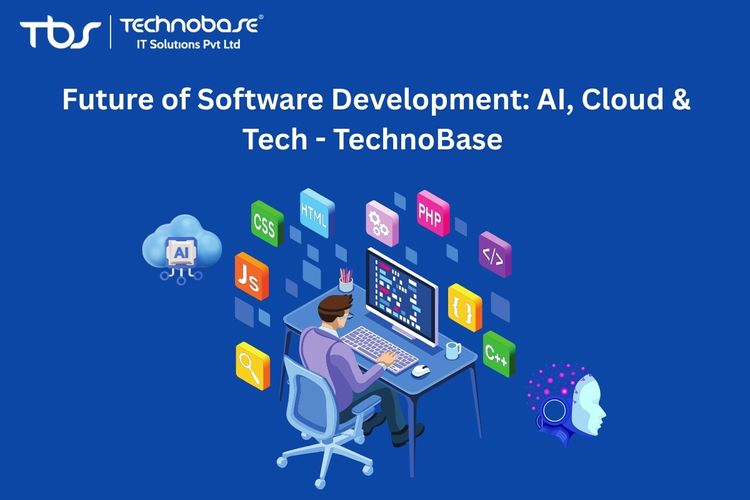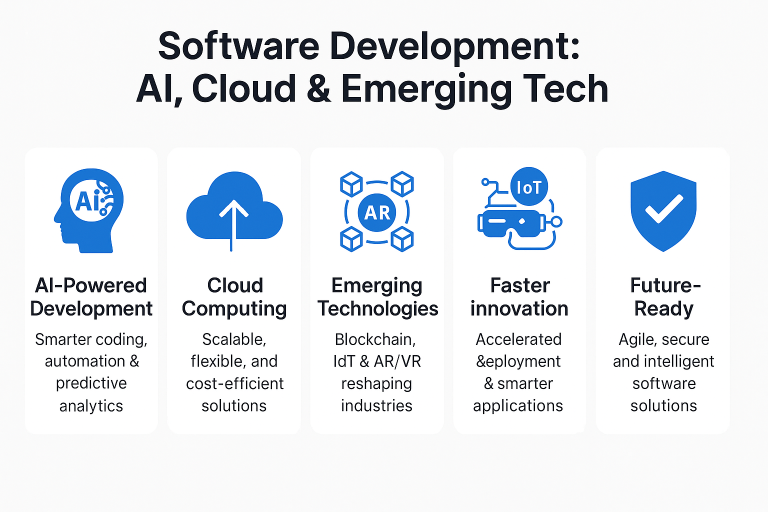The Future of Software Development: AI, Cloud, and Emerging Technologies
Do you still recollect how distributing computer programs used to mean burning a CD and wishing for the best? It feels like a century ago. The pace at which software development is being done today is astonishing. It feels like a world away when you have AI writing code, cloud computing infrastructures instantaneously scaling applications, and new tools and methodologies redefining the construction of digital solutions.
If you are a business leader strategizing for the next phase of digital advancement, you are going to have to view the developments in this area very seriously, more so if you are an experienced developer or a tech entrepreneur. It is going to become a lot more important to remain relevant and competitive in 2025 and the coming years

How AI is Revolutionizing Software Development
Gone are the days when an AI tool was limited to simple suggestions. Today, tools like GitHub Copilot and AI tools like ChatGPT and Claude can create whole functions, debug extensive problems, and even build an application from scratch.
These AI assistants do not just save time during the coding process; they are breaking down the rungs of the software development ladder. Junior developers under AI's tutelage can solve. senior developer-level problems, while more seasoned developers can attend to more architectural and strategic positions.
-Automated code review and bug detection
-Natural language to code conversion
-Test case generation and validation
-Documentation creation and maintenance
-Performance optimization suggestions
Machine learning capabilities are becoming standard features, rather than specialized add-ons. With pre-built APIs and frameworks, developers are now embedding predictive analytics, recommendation engines, and intelligent automation into their applications.
The consequence of this shift is that all software projects can now take advantage of AI without every software engineer having to hold a PhD in data science. There are cloud platforms that are ready to use ML models, which developers can implement with just a few lines of code.
Cloud-First Development Strategies

The serverless computing paradigm is no longer a hypothetical idea; rather, it has become a production-ready solution that is redefining the way we consider application structure. Functions-as-a-Service (FaaS) systems enable developers to put their business logic in the spotlight and leave scaling, maintenance, and availability to the infrastructure.
This model lowers operational overheads drastically and allows quick prototyping and deployment. It is also possible to launch applications faster (hours instead of weeks), test market hypotheses without huge investments in infrastructure.
Organizations are leaving behind single clouds for the multi-cloud and hybrid architectures. This strategy enhances resiliency and lowers vendor lock-in, as well as enables businesses to take advantage of the most appropriate services offered by various vendors.
Advantages of multi-clouds:
Geographic Distribution of reliability, Cost optimization by selection of best services, Enhanced security through diversified infrastructure enhanced compliance with regional data requirements.
Edge computing involves moving processing capabilities closer to the end users to minimize latency and provide better user experiences. The technology is especially essential in real-time usag,e such as gaming, IoT devices, and augmented reality experiences.
Application developers are creating edge-first architecture applications that spread computation over multiple locations to improve performance and lower the bandwidth expenses.
Future Technologies that will affect the future.
The increase in low-code and no-code platforms is broadening the list of who is capable of producing software applications. These visual development systems will allow business users to create useful applications without having to know standard programming languages.
Although these platforms will not substitute professional developers, they are altering the development ecosystem. It allows technical teams to concentrate on more advanced integrations and on custom logic whereas the business users can concentrate on a simpler workflow automation and data management tools.
Even though quantum computing is not yet commercial, farsighted developers are starting to consider quantum algorithms and quantum-classical-quantum hybrids. Cloud-based quantum computing is being provided by such companies as IBM, Google, and Microsoft as a means of experimentation and learning.
The quantum benefit will first manifest itself in areas such as cryptography, optimization, and the simulation of internal processes used in science. Now, developers operating in these fields should begin to become conversant with the idea of quantum programming.
AR and VR, and mixed reality merge and become the extended reality. Recent development platforms such as Unity, Unreal Engine, and WebXR are simplifying the development of immersive applications.
These technologies are diversifying out of the gaming industry to education, healthcare, manufacturing, and remote working. By 2025, the worldwide XR market is expected to reach up to 209 billion dollars, and this offers a huge potential to professional developers.
Security-First Development Practices
In modern software development, security is no longer a post consideration. DevSecOps is a business method that entails the incorporation of security tests and compliance checks into the development pipeline to have vulnerabilities identified early and fixed quickly.
Threat modeling, dependency checking, and automated security scanning have become the order of the day, part of continuous integration. This is a shift-left method of security that minimizes risk and speed-to-market.
Zero-trust security frameworks presuppose that no user or system must be implicitly trusted, wherever it is located or whatever credentials that user or system has. The developers are required to design applications using fine-grained access controls, persistent authentication, and detailed logging using this approach.
Leveraging the concepts of zero trust, API security, and user identity management should be thorough during application lifecycle implementation.
The Revolution in the Developer Experiences
New development teams use advanced collaboration tools, which combine code repositories, project management, communication, and deployment tools. These integrated spaces minimise the switching context and enhance team performance.
Is basic or fundamental collaboration:
Code editing and pair programming, in real-time, Integrated video conferencing and chat, Automated project tracking and reporting,and Cross-functional team visibility.
The dynamism in the technological landscape demands that the developers keep on upgrading their abilities. Coding bootcamps, interactive learning platforms, and peer-to-peer sharing of knowledge have all become crucial career development tools.
Organisations are spending much on employee learning and development programs because they realise that talented developers are their best competitive edge.
Preparing for the Future
The current and changing software development environment needs both technical know-how and soft skills to succeed. The knowledge of cloud platforms, the capability of integrating AI, and the awareness of security are becoming a requirement.
Problem-solving skills, communication skills and adaptability are also important. The most effective developers will be those who will be able to master new technologies promptly and cooperate with various teams.
Organizations should design their development teams in such a way that it is flexible and adaptive to learning. This involves designing career paths that would promote specialization whilst still ensuring that a team has a wide technical literacy.
The interaction between developers, designers, product managers, and business stakeholders in a cross-functional way will make sure that technical decisions are made based on business goals and the needs of the users.
Conclusion
Ready to navigate the future of software development? Technobase IT Solution is here to help you take every growing step in the software world. Our expert team combines cutting-edge technical knowledge with practical business experience to guide your digital transformation journey.
Contact us Now! Technobase IT Solutions for Customisable Software Development.
